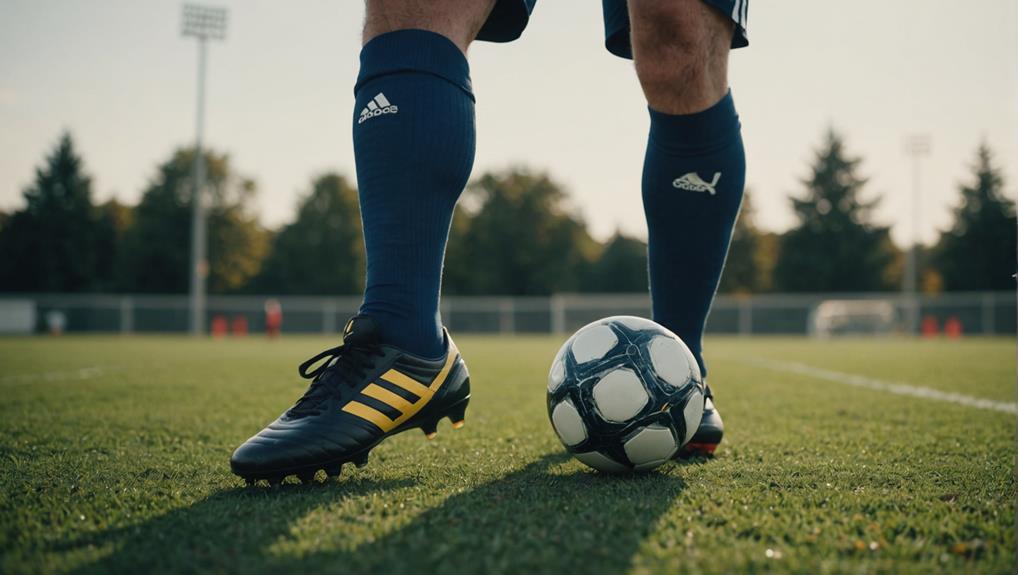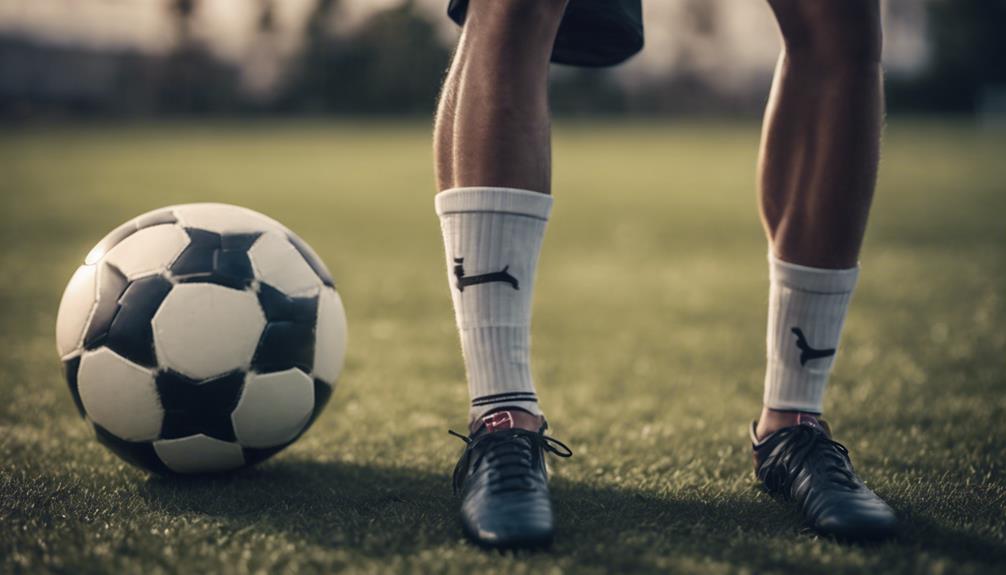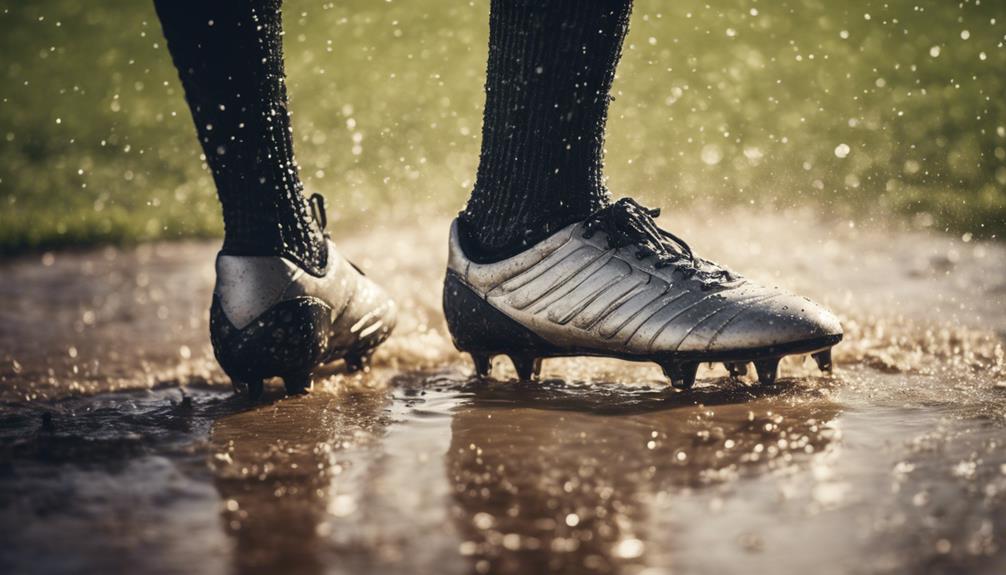
How to Break in Soccer Cleats for Maximum Comfort
August 12, 2024To break in your soccer cleats for ultimate comfort, start by evaluating the fit and feel to make sure they conform to your feet well. Focus on loosening the laces and walking around to gauge initial comfort and pliability. Then, ease into wearing them during training sessions gradually to adjust and prevent discomfort. Utilize stretching techniques like using a shoehorn or stuffing them with newspaper for a better fit. Consider wet methods like soaking in warm water for leather cleats. Remember, optimizing comfort will lead to peak performance and enjoyment on the field.
Initial Fit and Feel Assessment
Evaluating the initial fit and feel of your soccer cleats is vital for peak performance on the field. When you wear cleats for the first time, pay attention to how they stretch and conform to your feet. The pliability of the cleat's upper material plays an important role in determining comfort and flexibility during play.
Check the shape and width of the cleats in the forefoot and toes to guarantee a proper fit that enhances your agility and control. Additionally, assess the comfort of the ankle cut to avoid any rubbing or discomfort that may impede your movements on the field.
It's also helpful to compare the new pair of cleats to any previously successful ones you've worn to ensure a familiar feel that aligns with your playing style. Overall, a thorough fit assessment of your new cleats will establish the groundwork for a successful and comfortable playing experience.
Trying on New Cleats
When trying on new cleats, you should focus on evaluating the fit, comfort, and break-in potential.
Start by loosening the laces and walking around to gauge initial comfort.
Pay close attention to how the cleats conform to your foot shape and compare them to your previous successful pairs for best performance.
Fit Evaluation Techniques
To properly assess the fit of new soccer cleats, start by checking the pliability of the cleat's upper material for comfort and flexibility during play.
Here are some fit evaluation techniques to make sure you find the right cleats:
- Evaluate the shape and width of the cleat through the forefoot and toes for proper fit.
- Walk around in the cleats to evaluate comfort and support, considering any potential pressure points.
- Consider the break-in time needed for tight spots to secure a customized fit over time.
Comfort Assessment Methods
Examine the flexibility of the cleat's upper material first when trying on new cleats to confirm comfort and flexibility during play. Make certain the material feels soft and pliable, allowing for natural movement of your foot.
Check the shape and width of the cleats around the forefoot and toes to verify a proper fit that doesn't constrict or rub uncomfortably. Consider the comfort of the ankle cut, ensuring it doesn't cause any irritation or pressure points during wear.
Compare the new cleats to ones you've found comfortable in the past to estimate potential comfort levels. Additionally, take into consideration the potential break-in time required for any tight spots or areas that may cause discomfort initially.
Break-In Strategies
Assess the comfort and fit of new cleats by loosening the laces and walking around before fully lacing them up. This initial step allows you to gauge the initial feel and support of the cleats on your feet.
To break in your cleats effectively, consider wearing a pair of socks that you'd typically use during games to confirm an accurate fit. Here are some strategies to help you break in your soccer cleats efficiently:
- Evaluate the pliability of the cleat's upper material to see how well it conforms to your foot shape.
- Pay attention to the ankle cut of the cleats for both comfort and support during movements on the field.
- Check the width and shape of the cleats through the forefoot and toes to validate they match your foot structure.
- Compare the feel of the new cleats to your previous successful pair for guidance on what works best for you.
Easing Into Training Sessions

How can you gradually break in your new soccer cleats during training sessions to guarantee comfort and performance on the field?
Start by wearing your new pair for short periods while training. Remember to wear socks to create a barrier between your feet and the cleats. If your cleats get wet during practice, let them dry naturally to maintain their shape and prevent discomfort. Keep an eye out for any discomfort or hot spots that may arise. If needed, switch to a pair of mid-tier backup cleats to avoid blisters and maximize you can continue training comfortably.
It's important to prioritize comfort over style when breaking in new cleats. Allow your feet time to adjust to the new pair and focus on gradual wear to maximize comfort during training sessions.
Stretching Upper Material Techniques
To improve the comfort and fit of your new soccer cleats, utilize stretching techniques on the upper material. Here are some effective methods to help you achieve maximum comfort:
- Use a shoehorn: Insert a shoehorn inside the cleats to gradually expand the upper material, providing a more accommodating fit.
- Newspaper stuffing: Fill your cleats with newspaper to carefully expand the material and improve comfort while maintaining the shape.
- Mizuno MIJ shaping process: Consider the specialized shaping process of Mizuno MIJ boots for a customized fit that enhances overall comfort.
- Significance of comfort: The comfort of the upper material is essential for your overall comfort and performance on the field.
Shower Technique for Leather Cleats
When breaking in your leather cleats, using warm water in the shower can help soften the material, making it more comfortable for your feet.
The natural stitching of the leather will gradually adjust to your foot shape as you wear them post-shower, enhancing their performance on the field.
Embrace the practicality and effectiveness of showering with your cleats to guarantee maximum comfort and functionality during games.
Leather Softening Methods
Soaking your leather cleats in warm water is a highly effective method for softening the material and improving the fit. This technique aids in the break-in process by making the leather more pliable and comfortable against your feet.
After a warm water soak, allowing the leather to adapt to your foot shape naturally can enhance overall comfort and performance on the field. Switching to wearing wet leather cleats during training or games can further hasten the break-in process, ensuring a quicker adaptation period.
Showering with warm water while wearing the cleats helps shape them to your feet effectively, creating a custom fit. Stressing the importance of natural performance extension with this leather softening method to maximize the benefits of breaking in your soccer cleats.
Benefits of Showering
Showering with leather cleats on during the break-in process offers numerous benefits for softening the material and achieving a customized fit. The warm water from the shower helps to soften the leather, allowing it to mold to the unique shape of your feet.
As the leather expands in the shower, it becomes more pliable and comfortable, enhancing the overall fit of the cleats. Additionally, the stitching on leather cleats tends to loosen when exposed to water, aiding in the break-in process and promoting flexibility.
Choose the Right Size
Selecting the appropriate size of soccer cleats is vital for your comfort and performance on the field. When choosing the correct size, keep in mind that cleats are typically half a size smaller than sneakers to provide a snug fit while allowing room for toe movement. Ill-fitting cleats can lead to blisters, discomfort, and hinder your agility during play.
To make sure you get the right size, consider the following:
- Cleats are designed to fit tightly for improved control and reduced risk of injuries.
- Peak performance is achieved when wearing the proper size cleats.
- The right size cleats offer support and enhance your overall playing experience.
- Getting the appropriate fit is essential for comfort and avoiding foot issues.
Wet Methods for Breaking in Cleats

To enhance the comfort and fit of your soccer cleats, think about utilizing wet methods for breaking them in effectively. One approach is to soak your cleats in warm water to soften the material, allowing them to mold to your feet for a customized fit.
Wearing wet cleats with socks or undersocks can expedite the breaking-in process and help prevent blisters by reducing friction.
Showering with your cleats on is another method to explore, as the water can aid in stretching them out and enhancing flexibility for a more comfortable fit. This technique can also be beneficial in preventing blisters by pre-stretching the cleats before wearing them for extended periods.
For leather cleats specifically, wet methods are particularly effective as they can be easily molded and shaped to your feet when damp.
Conclusion
To sum up, breaking in your soccer cleats is essential for maximum comfort and performance on the field. By following these simple techniques, you can guarantee that your cleats fit perfectly and feel fantastic.
So don't worry – take the time to properly break in your cleats and you'll be outperforming the competition in no time!


